Wondering what the difference is between British vs American houses? When we first moved from the US to England, I thought I was prepared for the different definitions of normal here. I was… not. Things are definitely different, and can be surprising at times.
For some context, I grew up primarily in Texas and have also lived many years in California. I have family or friends all over the US. I’ve lived in apartments, condos and houses in the US. At certain points in my young adulthood I was moving every year chasing cheap rent.
Since moving to the UK, I’ve lived in two houses and visited many flats and houses our friends live in. Adjusting from US expectations to the reality of UK housing has been a learning curve. I’ve had to:
- figure out how to dry laundry in a rainy country without a dryer
- learn to cycle clothes seasonally through my tiny wardrobe
- sort out where to store items I previously thought lived in the bathroom, and
- try to avoid locking myself out of the house every time I walked outside
If you’re contemplating a move between the US and the UK, or just curious how things work on the other side of the Pond, these are the biggest differences.
This article contains affiliate links, which means that I may earn a small commission when you make a purchase. Affiliate links cost you nothing to use, and they help keep my content free – a win-win! For more information, see the affiliate disclosure.
GET READY TO MOVE TO THE UK WITH THESE TOOLS
✅ Be ready to drive on the left with Tripiamo’s comprehensive video driving guides.
✅ Future proof your finances (even if you’re in debt) with Slay the Stock Market (50% off with this link!)
✅ Save an average £167 per year on train travel with a UK Railcard
UK House vs. US House: Why Are They Different?
Before I dive into the details that separate housing between our countries, let’s look at five of the factors that drive the differences.
- Available space. Put simply, the US is a larger country with more unused land. The UK has higher land costs and stricter planning laws, both of which make it difficult to build American-style homes.
- Construction. The UK’s building infrastructure is older and there are often restrictions that prevent building changes. Meanwhile, much of American housing was built after WWII using less expensive building materials.
- Convenience. American culture prizes convenience. This extends into housing, making some things normal that UK residents would find extravagant and unnecessary.
- Climate. Weather in the UK is fairly temperate and less prone to some of the natural disasters that plague parts of the US. This has made climate control features in UK homes more of a luxury rather than a necessity.
- Voltage. Building codes in the US and the UK have evolved differently. Houses in the UK use higher voltage in power outlets, making cautious wiring more of a priority.
General Differences in British vs American Houses
1. Overall house size in the UK vs the US
Houses in the UK are smaller. Actually, they are a lot smaller. The average house size in the UK is 818 sqft (square feet). Compare that to the average house in the US at 2,164 sqft and you can see that things really are bigger in the US.

For many Americans moving to the UK, the space difference can be shocking. This is why I advocate strongly in my guide to packing for a move to the UK that American furniture be left behind. Most of it simply isn’t workable in a smaller UK home.
2. Attached vs detached homes
In the US, detached houses are very common. In fact, much of the country is used to having space between houses. There are some exceptions, but these are mostly in larger cities with dense populations.
Compare that to the UK, where shared walls are very common. This is true even in housing designed for families and outside major cities. You can find detached houses here, but they aren’t the majority and tend to be significantly more expensive.

Some of the different styles of home in the UK, with their American equivalent:
| British | American |
| Flat | Apartment or Condo |
| Maisonette | Blend between townhouse and condo |
| Terraced House | Townhouse / Brownstone |
| Semi-Detached | Duplex |
| Bungalow | Single-story detached home |
Semi-detached is the most common type of housing in England and Wales.
3. Air conditioning in the UK vs the US
Having spent much of my childhood in Texas, I was used to having air conditioning everywhere. Thankfully, the climate in England is much less hot, so you may think there is no need for air conditioning. Most of the year this is true.
Unfortunately, there are increasingly periods of heat in the summer that make living without air conditioning no fun at all. Many people purchase free-standing air coolers or window units to cope with these periods.
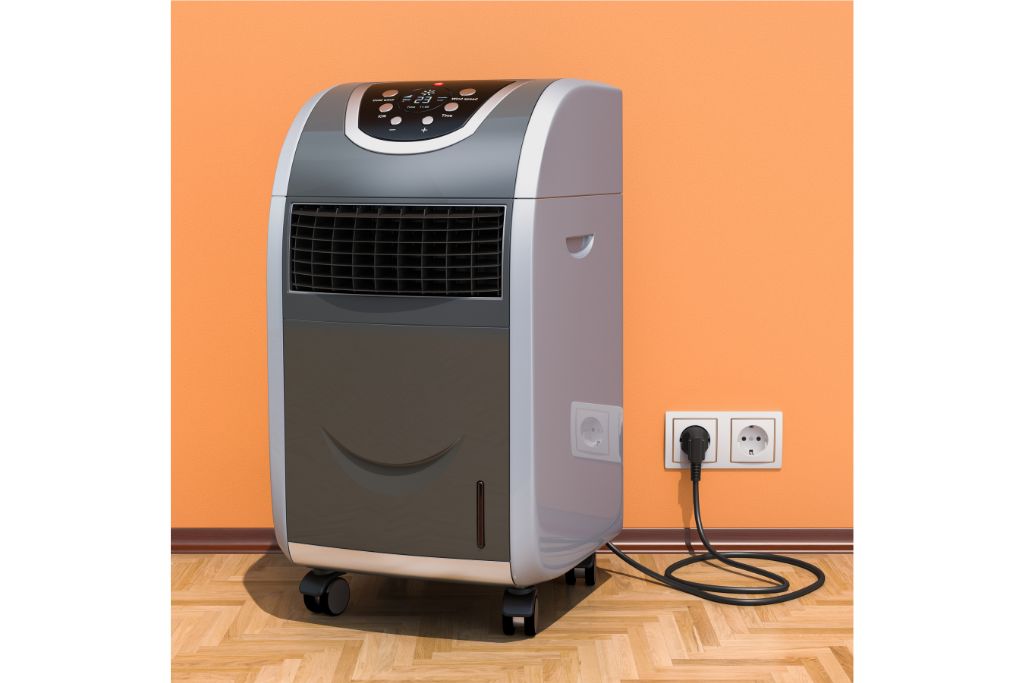
Shops and offices often do not have air conditioning either, so going out to cool down doesn’t always work. My daughter’s brand new school building does not have air conditioning.
Not having a forced air conditioning system also takes away a layer of air filtration you may be used to in the US. If you have allergies, then having only the breeze through the window for cooling can mean choosing between being hot and being itchy or sneezy. Hay fever medication is a regular part of life for many here.
With that all said, I do appreciate that my energy costs would be insane if I had the temptation to throw on a whole house air conditioner in the summer. It’s also probably more efficient to just cool single rooms.
4. Radiator heating in the UK vs the US
From hot to cold. Heating systems also look different in the UK compared to the most common heating in the US.
You can find radiators in much older homes in the US, but most have forced air heating that runs on the same air ducts as the air conditioning. As with air conditioning, the entire home is heated rather than individual rooms.

Here in the UK, most homes rely on radiators or individual room heating units. One of the houses we’ve lived in had a central heater, but we rarely used it. Heating just the rooms you are using helps keep energy costs down.
5. Walls of brick or stone in the UK vs timber and drywall in the US
The most common house building material in the UK is brick. This is true for both exterior and interior walls. I still remember standing in my daughter’s first UK bedroom with a hammer and a tiny nail planning to hang a light picture frame. I made some nice little chips in the wall, but there was no way I was getting that flimsy nail all the way in.
In spite of the learning curve for art installation (I’ve since landed on a love for 3M strips since we rent), there is one big benefit to brick or stone houses. We’ve had shared walls in each place we’ve lived and never had noise problems from our neighbors. These walls are great for noise insulation.
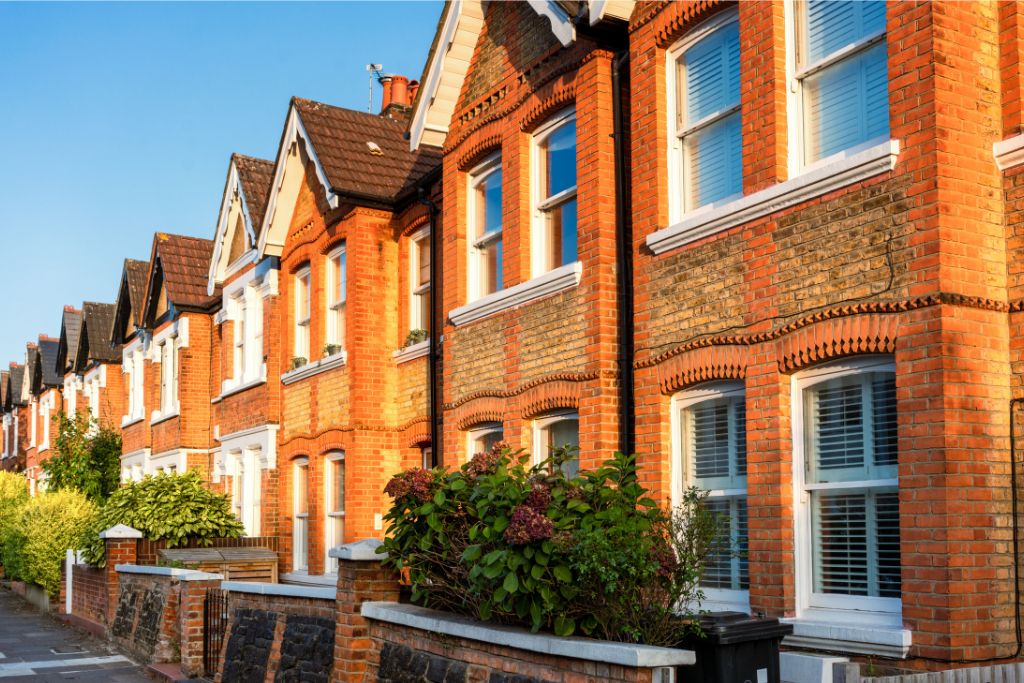
By comparison, timber construction in the US lets a ton of noise through. Neighbors having a normal volume conversation can often be heard through a shared wall. This is probably why Americans dislike shared walls in housing. If you’re contemplating a move from the US to the UK, don’t let attached housing scare you. It’s a lot quieter than you may expect.
If you’re wondering why the US has embraced timber construction, it is faster to put up and less costly. It’s also necessary in places like California where earthquakes require more flexible building materials that won’t fall apart when the ground shakes.
We used to live near the San Juan Capistrano Mission, which included the ruins of a beautiful old church. It was built with stone and fell in only 15 years after completion during an earthquake.
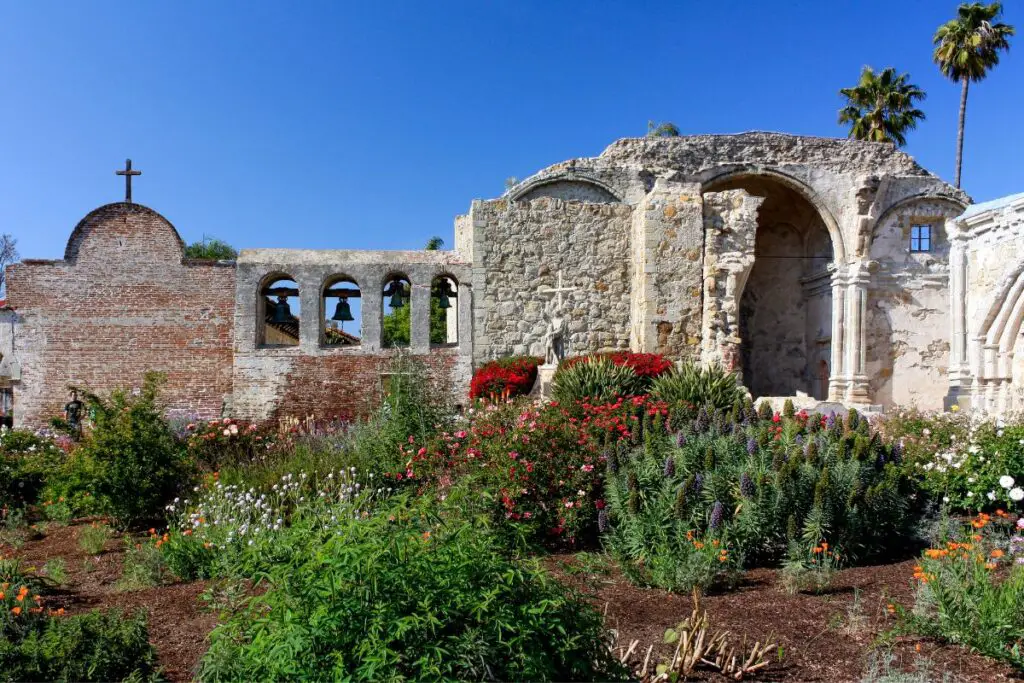
6. Hallways and separated rooms in the UK
Open concept floor plans are not common in the UK. In fact, you may find “2 receptions” advertised on house listings to indicate there are multiple rooms that could be used as a living room. By American standards, these two rooms could be very small for that purpose.
Especially in older homes, you’ll find more interior walls separating rooms. For example, kitchens are sometimes large enough to include a dining area, but it’s rare to find a kitchen opening directly to a living space.
By comparison, open concept housing really took off in the US. It’s common to find houses where the kitchen, living room and dining room have no walls separating each area.
7. Usable basements uncommon in the UK
I never had a basement in either Texas or California, but many parts of the US consider them a normal part of any house. By comparison, I’ve only found a handful of homes with a basement in the UK.
UK cellars were often built for coal storage and are somewhere between bleak and nightmare fuel today. At best, you might use these to store seasonal items as you would in a garage.
8. Stairs are steeper in the UK than in the US
Houses in the UK seem to have slightly steeper stairs than what’s normal in the US. It’s not a huge difference, but something you’ll notice if you’re used to living with stairs in the US.
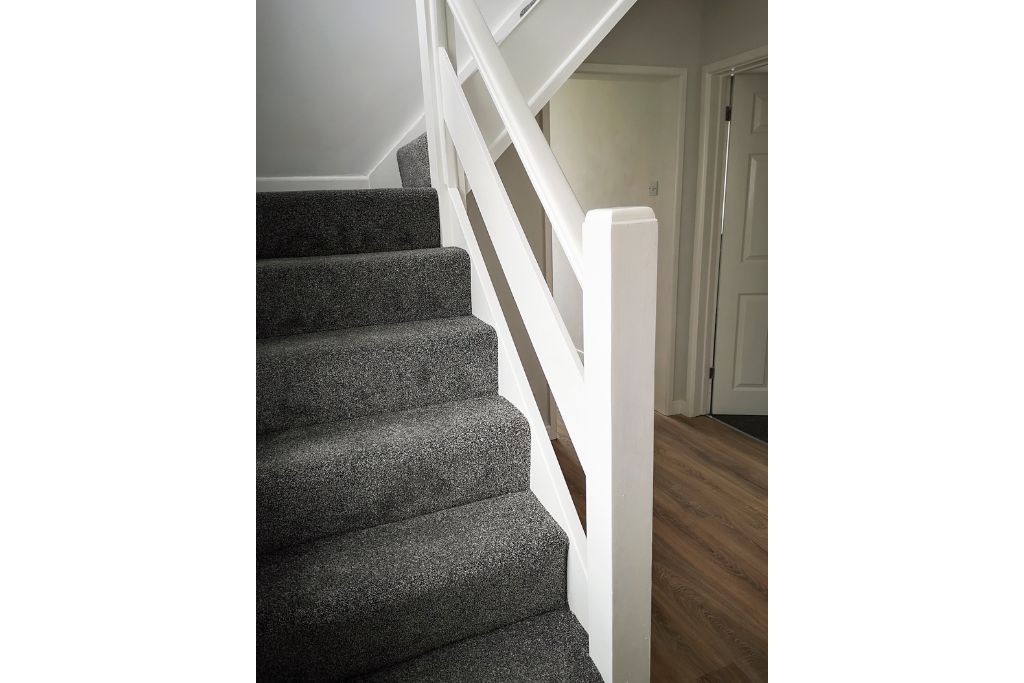
I remember worrying about this when we first moved to England because my daughter was still pretty little. Thankfully, it never became an issue and we all got used to it. Now I barely notice a difference.
9. Wall switches on outlets in the UK
This difference started out as something really annoying that I now love. Basically, every electric outlet in the UK has a switch next to it that turns the individual outlet’s power on and off. Your hair dryer isn’t broken, it’s just plugged into a switched off outlet.

I love having this now because it’s easy to flip off outlet power when we are going to be away without unplugging a bunch of stuff. It feels safer, though I can’t say for sure whether it really is or not.
10. Fighting damp in the UK
From something to love to something to hate. Damp is a common problem in UK houses and basically refers to creeping damage or mould from wet conditions that seep into the house.
Condensation is the most common difference that you’ll encounter. Go to sleep in the winter with the windows closed and wake up to a layer of condensation on and around the windows.
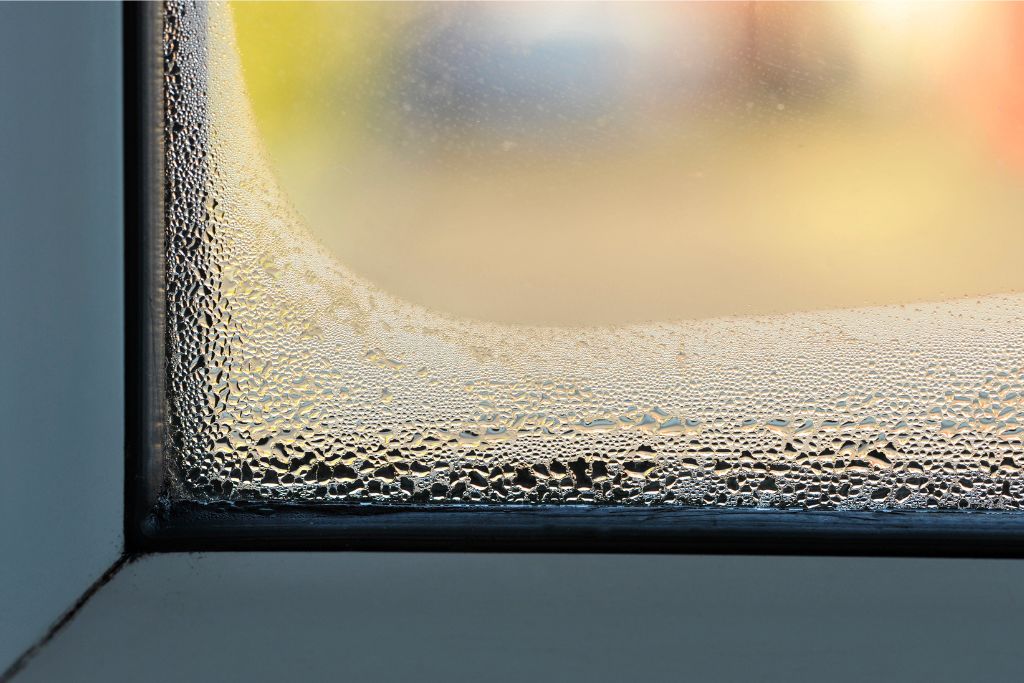
More serious forms of damp are caused by water seeping through brick walls to damage the interior of the house. Severe damp can rise to the point of making housing unfit, but most of the time things don’t get that bad.
Even if you live in a well-constructed house, you’ll need to wipe down condensation and keep an eye out for mold growth. When I lived in the US, finding mold in my house would thoroughly freak me out. Here, it’s a pretty normal part of winter life that takes a little extra clean up effort.
11. No window screens in the UK
Window screens have been common in the US since the 1950s. Today they are a normal and expected part of housing across the US. They keep out bugs, which is really helpful in parts of the US that see a lot of creepy crawlies.
In the UK, it’s really uncommon to find a house with screens on the windows. I can’t think of any that I’ve encountered actually. I occasionally see people in expat forums talking about making DIY screens from parts ordered on Amazon. So if you’re really bothered by it, there are options out there.

There are fewer bugs here, but this does mean those few have free entry when the weather is nice. The only ones that drive me nuts are the idiotic flies that zoom in and then need approximately 200 circuits of the room before they can find the exit.
12. Building extensions more common in the UK
Buying and selling property is a major undertaking with a lot of associated costs. As a result, it’s pretty common for British homeowners to expand their existing home rather than selling to buy a larger place.
Whether you’re renting or buying, you’ll encounter attic (loft) conversions, garage conversions, and home expansions. This can sometimes bring a larger American-style main bedroom into an older property, or expand a kitchen to a larger footprint.
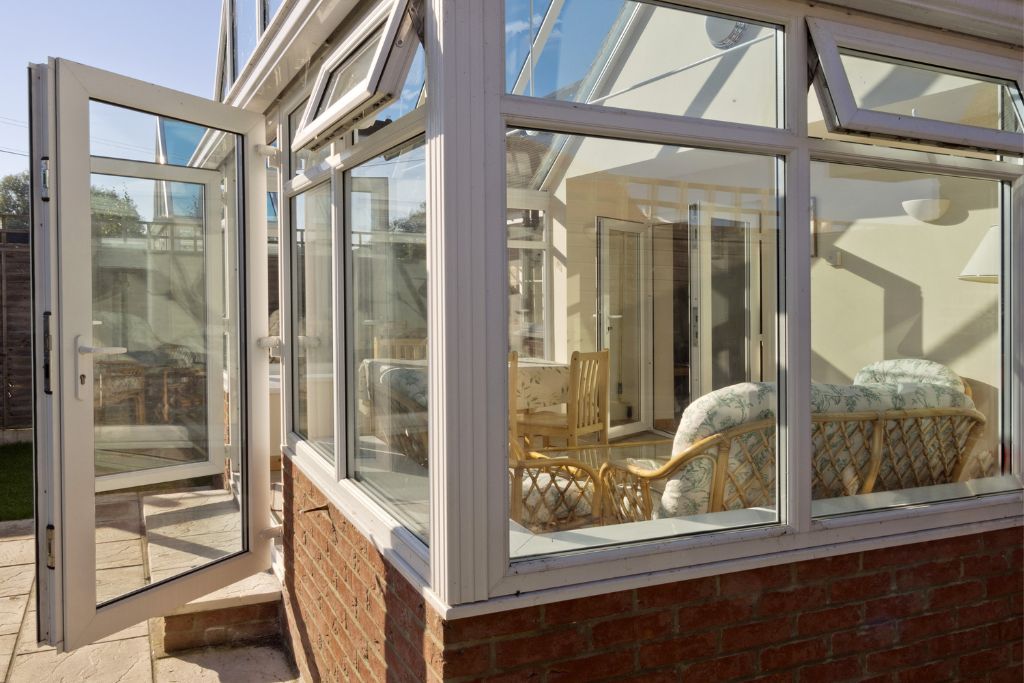
One of my favorite building extensions in the UK is the conservatory. These are popular in suburban neighborhoods with garden space that can be brought into the house footprint. A conservatory is a greenhouse-like room that has extensive glass walls and ceiling. Given the changeable nature of British weather, it’s a nice way to feel outside without going outside.
13. Your front door in the UK might lock when you close it
I don’t want to talk about how many times I’ve locked myself out of the house. In the US, most entry doors lock with a deadbolt that requires you to put a key in the exterior lock and turn before the door locks. Electric deadbolts are increasingly common that you can lock or unlock from your phone.
Here in the UK, you may have a deadbolt lock on your door. However, a lot of doors have locks that engage as soon as you shut the door. That’s great except for that time you went to take the garbage out and the wind blew the door shut behind you. Not that I know what that feels like…
I’m now well programmed to only go outside with a key in my pocket. I will also always annoy my husband by asking whether he has keys every time we go to walk the dog together. I vastly prefer the American system on this one.
14. Disclosing a death in the house UK vs US
Knowing someone died in the house you’re buying can be a big deal to an American. In fact, some states in the US require sellers to disclose deaths on the property.

Meanwhile in the UK, it may not be a discussion at all. So many properties were built at a time when most people died at home without a record, so historical deaths are rarely disclosed. There are now consumer protection regulations that require disclosure of a murder or suicide, but even these are silent when it comes to death from natural causes.
Bedroom Differences in British vs American Houses
15. Smaller bedrooms in the UK vs US
Just like houses tend to be bigger overall in the US, bedrooms also get more space there. In most states, a bedroom needs to be at least 70 sqft (6.5 sqm).
It’s also common to find primary bedrooms in the US that are significantly larger than the secondary bedrooms. Houses are built for single families where parents take the largest bedroom and smaller bedrooms are for kids or guests.
Bedrooms in the UK are often measured as either double rooms or single rooms. This refers to whether you can fit a double bed or a single bed into the room. I’ve seen many single rooms that would be lucky to fit a crib or toddler bed at best.
Primary bedrooms in the UK may be the same size or only slightly larger than secondary bedrooms. When we first moved back to the UK, our daughter’s bedroom was the same size as the bedroom my husband and I share.
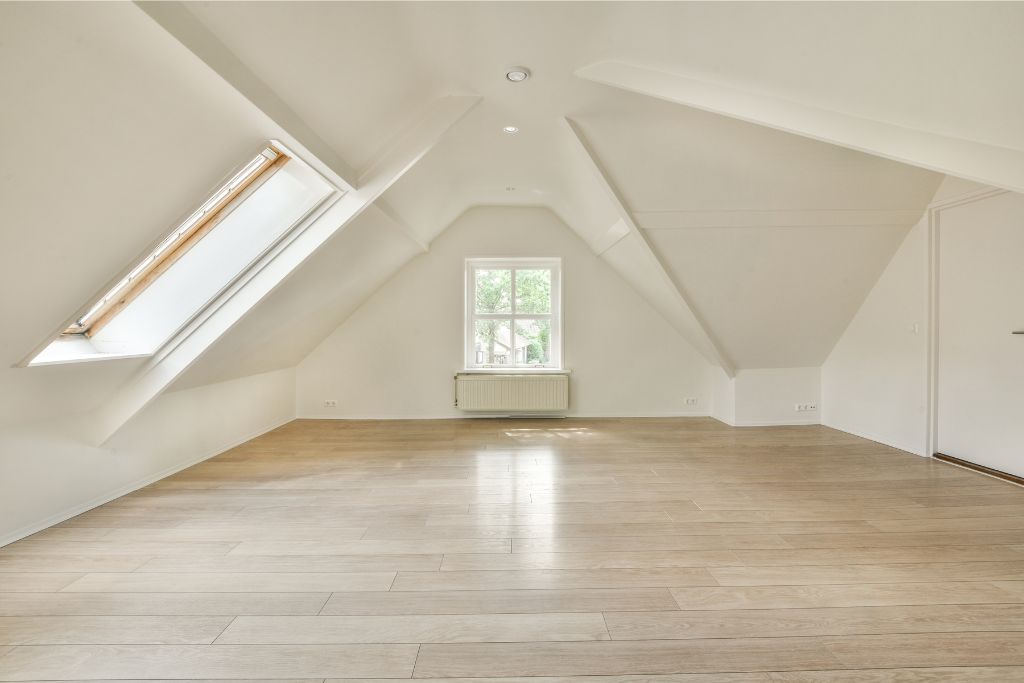
Houses that have been expanded by converting a loft (attic) are more likely to include a larger primary bedroom – maybe even with an en-suite bathroom attached. Newer builds also sometimes have a larger primary bedroom in the floorplan.
16. Closet space in the UK vs US
You are much less likely to find built in closets in UK bedrooms. Really, it’s not common to find built in closets much anywhere in UK houses. Our first house had a cupboard under the stairs (very Harry Potter). There was also a small cupboard space in our bedroom that housed the hot water tank with little room for anything else.
Newer build UK homes sometimes have small closets, but freestanding wardrobes are still the most common clothes storage option.

If you move from the US where built-in closets are standard, the difference here can be surprising. Our 1960s-built home in California had much more closet space than we have now, and our house in Texas had a walk-in closet larger than some UK bedrooms.
Since moving to the UK, I circulate seasonal clothing in and out of storage. This is something I wouldn’t bother with if there was more dedicated storage space.
Bathroom Differences in British vs American Houses
17. Family bathrooms in the UK vs US
When we lived in Austin, Texas, I loved the older bungalow-style houses near the city. I couldn’t imagine living in one, though, because most only had one full bathroom and I didn’t want to share with the whole family. Oh, how my attitude has changed.
Newer build homes in the UK are adding more bathrooms to standard floor plans, but many places will still have just one family bathroom that includes a combination bathtub/shower, a sink, and a toilet. Some homes also have a water closet (W/C), which is sort of like a powder room in the US – just a toilet and sink.
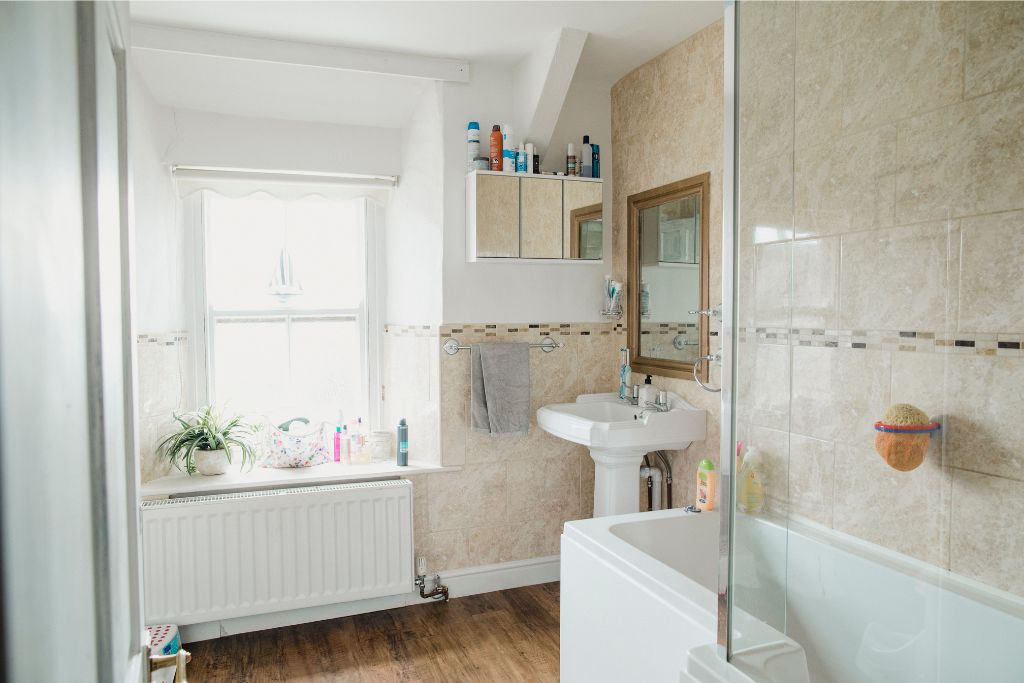
As many homes in the UK are much older than those in the US, you sometimes find bathroom additions in interesting places. In the first house we rented in the UK, there was a W/C essentially in the garage. I called it the spider bathroom because there was just no keeping the spiders out of it no matter how often I cleaned.
Some houses pre-date indoor plumbing and now have one very nice bathroom, but it’s weirdly annexed off the kitchen because that was the easiest spot for adding plumbing during an extension.
Sharing a bathroom with family is much less common in the US. Having an en-suite bathroom off the primary bedroom is the norm. Secondary bedrooms for kids or guests then have another full bathroom nearby. It’s typical to have a bathroom or powder room on each floor of the house for multi-story homes.
18. Smaller bathrooms in the UK vs the US
Continuing our trend here, bathrooms are also smaller in the UK than they are in the US. The biggest reason for this is the difference in counter space. In the US, expansive cabinets surround the sink with miles of countertop. In the UK, you are more likely to find a sink with limited or no counter around it.

Again, newer builds and extensions sometimes place larger bathrooms into UK homes. Maybe I’m just not posh enough, but I’ve yet to encounter a UK bathroom that rivals what most Americans would consider normal for a primary bathroom. Storage can get cramped in the UK without counters and often without built-in cabinets.
19. No regular outlets in UK bathrooms
Ready to blow dry your hair? That’s not going to happen in the bathroom. While US bathrooms typically include electrical outlets, you won’t find the same in the UK. This is primarily a safety requirement, which makes sense when you think about it. The only outlets you may find in a UK bathroom are lower voltage specialty outlets for electric shavers.
Between the outlets and lack of counters, I’ve found it easier to embrace having a make-up table in the bedroom. Basically, skin care lives in the bathroom, but make-up and hair styling gets moved out.
20. Light switches outside the bathroom in the UK
As with the lack of wall outlets, you are also less likely to find the power switch for lighting inside the bathroom. Sometimes the light turns on with a pull cord that dangles from the ceiling.
If it’s a wall switch, though, it might be outside the bathroom door. I can only imagine how much my brother and I would have tortured each other growing up if we could have flipped off the lights whenever we walked by.
21. Toilet water in the UK vs the US
Now for something a little gross, but definitely different. Toilets in the US have so much more water. People who visit the US for the first time often remark on this – it is weird if you’re not used to it.
By comparison, toilets in the UK hold a small amount of water in the bottom of the bowl, and then flush with more water. The part where this gets a bit gross is the reality that less water means more… streaks. I find you need to scrub the toilet here a bit more often just to keep things from getting icky.
22. Separate hot and cold faucets in the UK
More about water, but without the ick. While this is becoming less and less common, you will still find some sinks in the UK that have separate taps for hot and cold water. This comes from a time when only cold water was fit for drinking so separate taps prevented contamination. Today, you’ll find this mostly in older homes or water closets.

Kitchen Differences in British vs American Houses
23. Dishwashers in the UK vs the US
Most American homes have a dishwasher appliance in the kitchen. Here in the UK, your mileage is much more likely to vary. Most of the houses we’ve rented included a built-in dishwasher, but not all. It’s fairly common to find kitchen sinks with built-in drying racks whether you have a dishwasher or not.
What isn’t common (but would help a lot with the manual dishwashing) is a spray hose on the sink. I don’t think they are impossible to find, but I’ve yet to encounter a sink in a home kitchen that had this feature built in.
24. Refrigerator size in the UK vs the US
We once rented a house with an “American-style” refrigerator. Anything in the UK that is labeled “American-style” is going to be bigger. In our house that means we had a side by side refrigerator/freezer. It even had an icemaker – so posh!
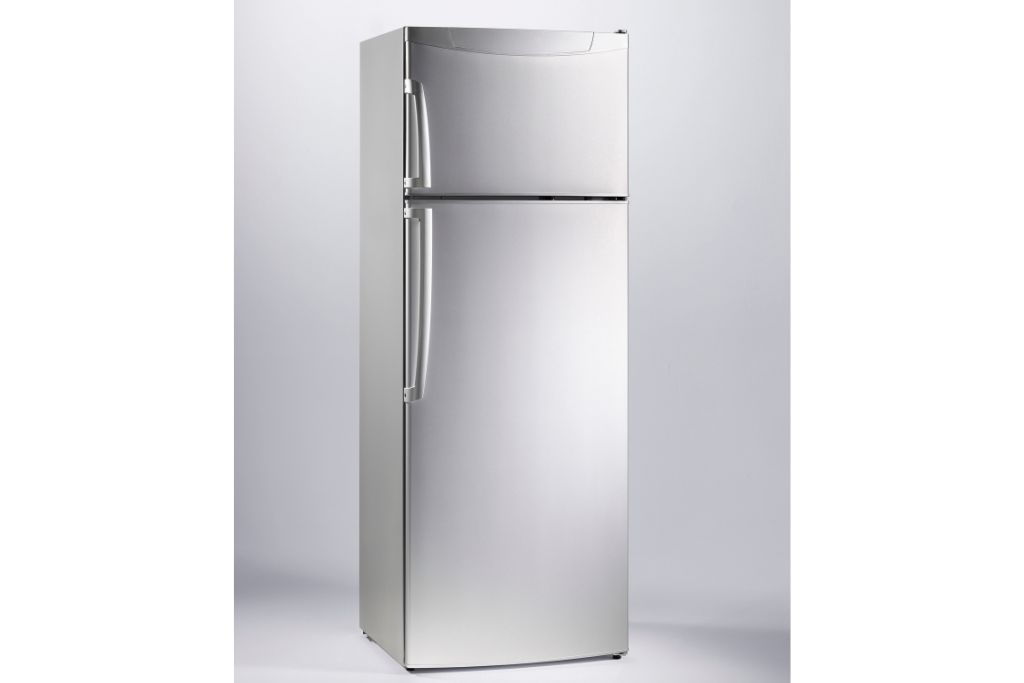
Many houses, and especially flats, in the UK have way smaller refrigerators. It’s not uncommon to find a refrigerator in a flat that is the equivalent to a dorm fridge in the US. This is especially true in major cities, but at least it’s much easier to grocery shop more frequently there.
25. Electric kettles in the UK vs the US
I’m not sure there is anything about daily life in the UK that I have come to rely on as much as my electric kettle. It’s fantastic and Americans should really get on board with this one.
Making a coffee or cup of tea? Kettle.
Boiling water for cooking? Kettle.
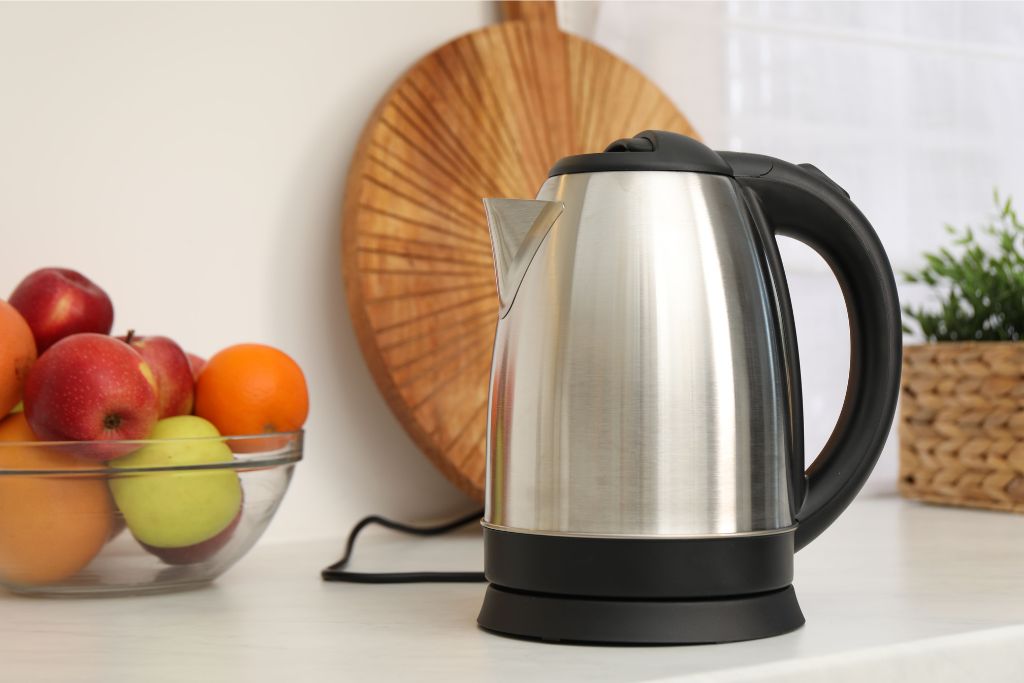
Americans are much more likely to microwave water to heat it – an excellent way to horrify your new British friends by the way. Now that I’ve gotten used to using a kettle, I can’t imagine my life without it.
26. Garbage disposals and food waste in the UK vs the US
You are much less likely to find a garbage disposal system in your UK sink. This generally comes down to older plumbing systems that aren’t designed to handle food waste mixed into the water. I have seen them available in home supply shops, but don’t know anyone who has one installed.
Most UK sinks instead have a strainer to catch food waste. You then dispose of the caught food in the trash or compost. Many UK cities have food waste recycling programs. If you live in one of these areas, then you’ll keep a small bin to collect food waste and then put it out for pick up on designated days.
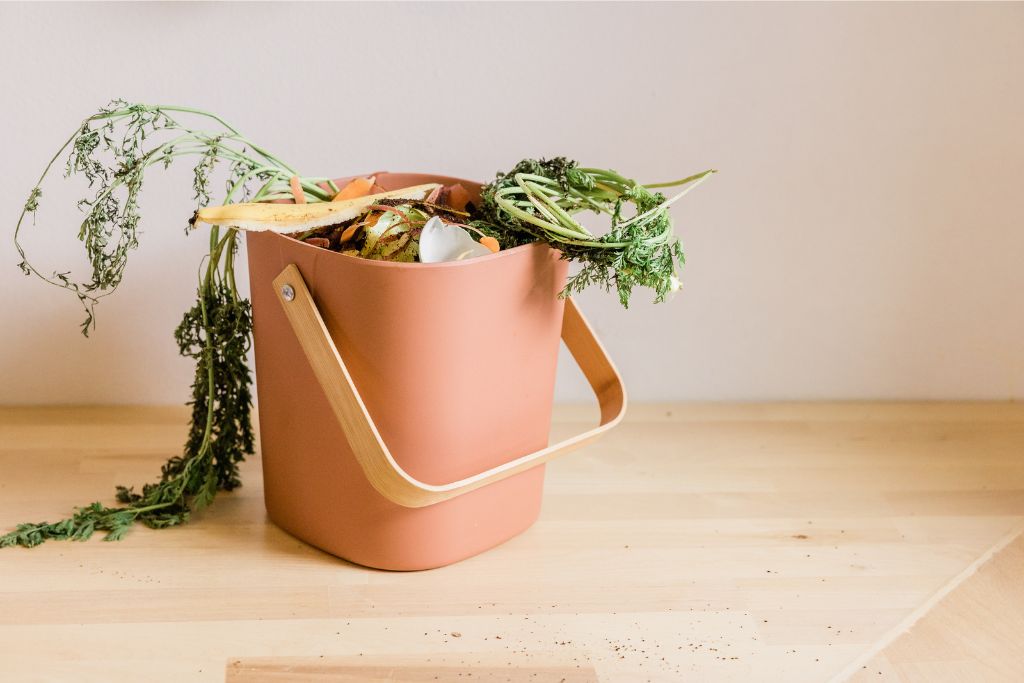
27. Laundry in the UK vs the US
Where and how you handle your laundry can be very different in the UK vs the US. Many homes in the US have dedicated laundry rooms with space for separate washer and dryer. Older US homes may have the washer and dryer in the garage.
The most common spot to find laundry in the UK is in the kitchen. Sometimes it’s just a washer, sometimes a washer/dryer combination. Though keep in mind that combination units never get your clothes actually dry.
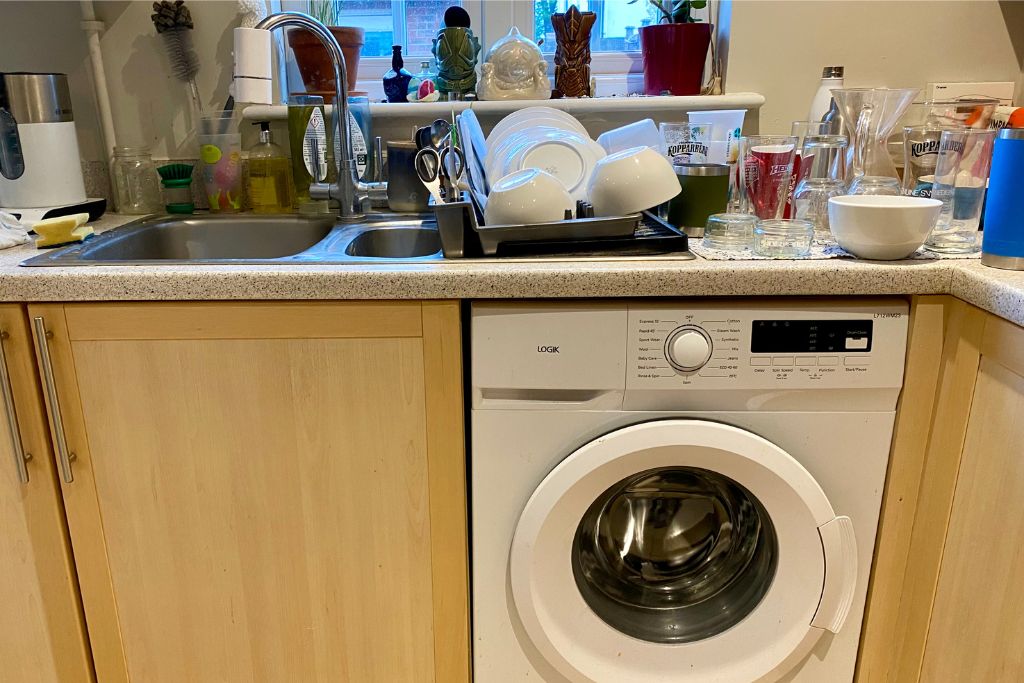
You would think in a land as known for rain as the UK that line drying would have gone out of fashion by now. Unfortunately, that’s still a very common method for drying clothes here. If you have a garden, then there may be a line out for hanging laundry. Otherwise you’ll need a collapsible drying rack or start hanging your clothes off radiators (don’t do this).
Outdoor Differences in British vs American Houses
28. UK gardens vs US yards
I initially thought that a garden vs a yard was just a different term for the same thing. However, there are a few more differences. UK gardens are smaller than many US yards, and often include less manicured grass.
Since many houses are attached to the neighbors in the UK, there is often no gate access to the back garden. In the houses we’ve rented, we accessed the back garden through a garage or by walking through the house.
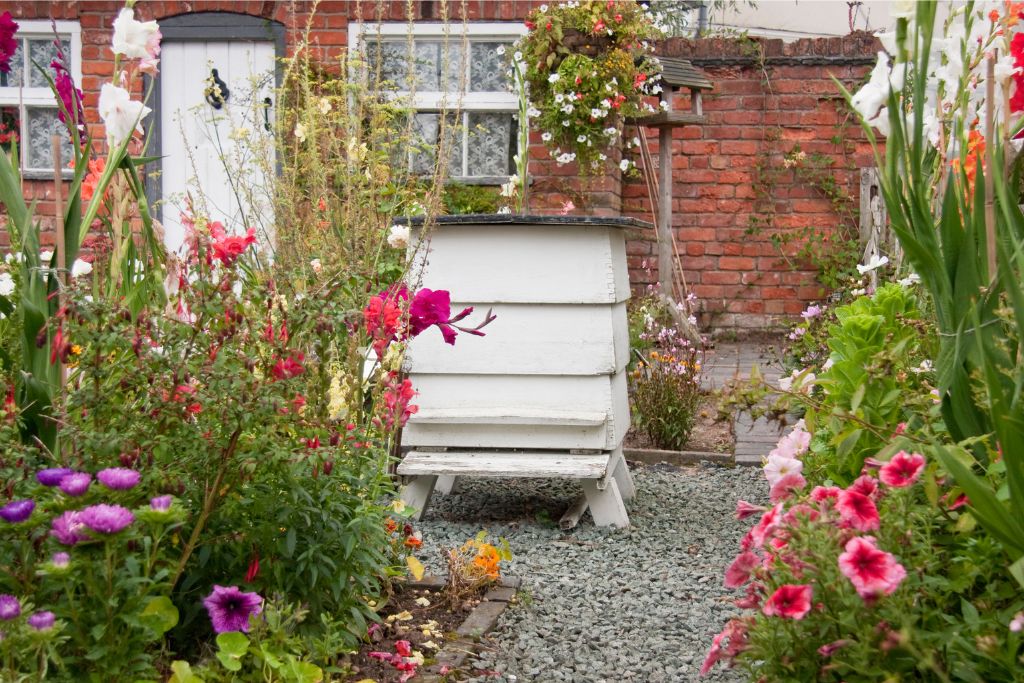
In flats and shared building houses like maisonettes, it’s possible to have access to a garden that isn’t directly connected to your home. A temporary flat we lived in when we first moved back here had a dedicated garden, but we had to leave the building and go around the side to access it. Our flat was on an upper floor and the directly connected garden space was allocated to the ground floor flat.
29. Mail delivery in the UK vs the US
I’ve never seen an American-style mailbox here in the UK. It’s common in the US to have a mailbox at the end of your driveway that fits letters and small packages. When you want to send out mail, you simply put it in the mailbox for pickup.
Apartments and some newer US house developments have central post boxes that you access with a key. These usually include a few larger boxes where packages can be delivered. If you receive a package, then you get the package box key in your dedicated post box.

Instead of a mailbox, most UK houses and flats have mail slots in the front door. Packages will either be delivered through the mail slot or the post deliverer will knock on your door to hand it over. If you miss a package delivery they may deliver it to a neighbor or put it in a hidden spot near your door.
When you want to mail something in the UK you look for a red postbox for letters. These are usually scattered around neighborhoods so it’s rare you need to travel far to find one. For packages or when you need to buy postage, there are post offices included in many corner shops.
30. UK postcodes vs US zip codes
Speaking of mail, UK postcodes are so much more specific than US zip codes. If I had someone’s zip code in the US, then I could narrow down the address to a region.
Here in the UK, I often put in my postcode first for online shopping checkout. Once the retailer has my postcode, the website automatically populates just the houses on my road.
More Culture Shocks Between the US and the UK
The differences between life in the US and the UK go beyond housing. For more of what to expect in the UK and help planning your move, check out these guides
- Can I move to the UK? Guide to visas and options for moving to the UK
- Pros and cons of life in the UK. Guide to the common highs and lows experienced by Americans living in the UK.
- Move your money between the US and the UK. How to get your money from there to here without insane conversion fees.
- Mistakes to avoid moving pets to the UK. Tips to make moving pets a smooth experience.
- Cost of moving pets to the UK. Guide to the overall cost of international pet moves.
- Choosing a UK school for your child. Tips for navigating the British school system and picking the right school for your situation.
- The hardest part of moving to the UK. Help for handling the uncertainty of life abroad.
- Coping with expat homesickness. Tips for managing the inevitable roller coaster of expat life.
- American guide to British grocery stores. Where to shop and why where you shop matters.
- American guide to driving in the UK. What you need to know before you hit the not-so-open UK roads.


